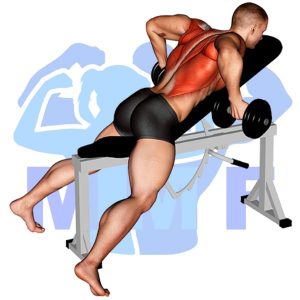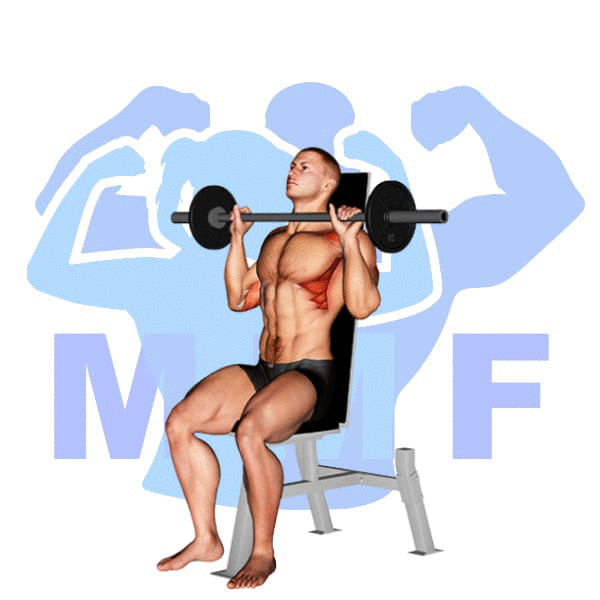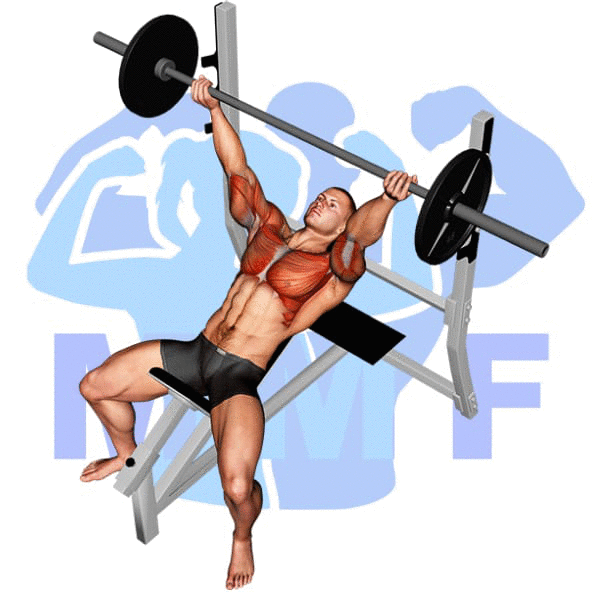Do you struggle with targeting the muscles in your shoulders and upper back? Perhaps you’ve heard of the barbell rear delt raise, but you’re not sure how to correctly execute the exercise. You’re not alone. Many fitness enthusiasts find it challenging to focus on these specific muscles, causing a lack of development and strength in the upper body. Don’t worry; this is a common problem that is easy to remedy with proper form and technique. In this post, we will teach you the correct way to perform the barbell rear delt raise and provide valuable tips to help you achieve optimal results. Say goodbye to weak shoulders and hello to a stronger, more defined upper body.
Barbell Rear Delt Raise Summary
- Primary Muscles: Deltoid – Posterior
- Secondary Muscles: Biceps Brachii, Brachialis, Brachioradialis, Deltoid – Lateral, Levator Scapulae, Trapezius – Upper, Wrist Flexors
- Equipment: Barbell
- Mechanics Type: Isolation
- Force: Pull
- Utility: Auxiliary

Barbell Rear Delt Raise Instructions
- Grab your barbell behind you back with an overhand grip and your palms facing back.
- Starting with you arms extended, then pull the bar upward behind your back.
- Once you have reached your maximum range of motion, lower the barb back down by extending your arms.
- Repeat these deltoid raises until your set is complete.
Video Tutorial
Barbell Rear Delt Raise Muscles
Target (Agonist)
Synergists
- Biceps Brachii
- Brachialis
- Brachioradialis
- Deltoid – Lateral
- Levator Scapulae
- Trapezius – Upper
- Wrist Flexors
Dynamic Stabilizers
- Biceps Brachii – Short Head
Stabilizers
- Pectoralis Minor
Antagonist Stabilizers
- None

Benefits of Barbell Rear Delt Raise
The Barbell Rear Delt Raise is an excellent exercise for strength training or fitness routines as it targets the posterior deltoid muscle. This exercise not only strengthens the back of the shoulder, but also helps to stabilize the shoulder joint, preventing injury. Additionally, this exercise can help to improve posture, as well as increasing overall muscular endurance. As a result of performing this exercise regularly, one can expect to see increased muscle size and definition in the posterior deltoid muscle.
Tips for Performing Barbell Rear Delt Raise
This exercise is a great way to target your rear delts and strengthen your shoulders. To get the most out of this exercise, follow the tips below.
- Lift Near A Place Where You Will Be Able To Assess Your Form In A Mirror. You need to have the opportunity to keep good form on every single rep, so you can achieve that you should have the ability to watch and fix your technique.
- Ensure That You Pencil In Recovery Days. When you still want to exercise, instead of recovery you are able to incorporate into your program with cardio. Only remember to let your muscles to heal, healing is how your muscles grow.
- conduct your primary compound lifts at the beginning of your routine, after that do isolation movements to concentrate on single muscles towards the end. You really want the pinnacle performance of your individual muscle groups whenever you accomplish compound lifts including, deadlifts, bench, and squats. Then you want to work the muscle groups of which you identified were weak for those movements, or areas that couldn’t get worked as a result of the type of compound exercise you did.
Benefits and Tips Video
Frequent Mistakes To Avoid
It is important to remember that form and technique are key when performing barbell rear delt raises. To ensure that you are performing the move correctly and getting the most out of the exercise, here is a list of common mistakes to avoid.
- Stop Trying To Lift Alone. Your partner are generally an amazing driving force. A partner may end up being useful spotter.
- Avoid The Urge To Execute The Same Exercises Each And Every Time. When people execute exactly the same lift every exercise session your muscles will be taught to complete that single lift effectively, and you will peak quicker.
- Try Not To Neglect Your Own Pain. Tender muscle tissue and pain from injuries are certainly not the same. As soon as you appear serious pain any time you are doing exercises you should certainly stop, or you can simply make the injury worse yet.
Find More Barbell Exercises Here
Variations and Complementary Exercises
There are many other exercises that can be done to target the same muscles as the Barbell Rear Delt Raise. These exercises can be used as variations, complementary, or alternative exercises to the Barbell Rear Delt Raise. Below is a list of some of these exercises that can be used to target the same muscles:
Barbell Reverse Grip Bent Over Row

The Barbell Reverse Grip Bent Over Row is a great complementary or alternative exercise for the Barbell Rear Delt Raise. This exercise targets the posterior deltoid muscles and works the back, shoulders, and biceps. The bent over position of the exercise allows for a greater range of motion and helps to target the muscles more effectively. It also helps to improve posture and strengthen the core muscles. This exercise is a great addition to any workout routine as it provides a great way to build strength and size in the back, shoulders, and biceps.
Cable Rope Rear Delt Rows

Cable Rope Rear Delt Rows are a great complementary or alternative exercise to Barbell Rear Delt Raises. This exercise targets the rear deltoids, as well as the middle and lower traps, and the lats. It can be performed using a high pulley machine with a rope attached to it. To perform this exercise, stand facing the machine with your feet shoulder-width apart and hold onto the rope with both hands. Pull the rope towards your chest while keeping your back straight and your shoulders down. Then return to the starting position slowly. This exercise is beneficial for improving posture and strengthening the rear delts, as well as other muscles in the upper back.
Dumbbell One Arm Rear Deltoid Row

The Dumbbell One Arm Rear Deltoid Row is a great exercise for targeting the rear delts and can be a great alternative or complementary exercise to the Barbell Rear Delt Raise. This exercise can be done using a flat bench, a dumbbell, and a barbell. To perform this exercise, you will begin by lying on your stomach on the flat bench and grabbing the dumbbell with one hand. From here, you will pull the weight towards your chest in a rowing motion, squeezing your shoulder blades together at the top of the movement. This exercise can be used to build strength and size in the rear delts, making it an effective alternative or complement to the Barbell Rear Delt Raise.
Check Out These Top Barbell Exercises
Dumbbell Palm Rotational Bent Over Row

Dumbbell Palm Rotational Bent Over Row is a great alternative or complementary exercise to the Barbell Rear Delt Raise. It works the same muscles in the shoulders, namely the posterior deltoids, as well as the rhomboids and other muscles in the upper back. It also adds a rotational component to the exercise, which can help with shoulder stability and overall shoulder health. It can be performed with a light weight in order to focus on form and technique, or with a heavier weight for more of a strength building exercise.
Smith Machine Bent Over Row

The Smith Machine Bent Over Row is an excellent complement or alternative exercise to the Barbell Rear Delt Raise. It works the same muscles in the back and shoulders but requires a different technique, as the barbell is replaced by a vertical bar. To perform this exercise, stand with your feet shoulder-width apart, hold the bar at shoulder height and bend your knees slightly. Pull the bar towards your chest while keeping your back straight and your core engaged. This exercise strengthens the back, shoulders, and core muscles, providing an overall workout that is complementary or an alternative to the Barbell Rear Delt Raise.
Underhand Dumbbell Row

Underhand Dumbbell Row is a complementary exercise to the Barbell Rear Delt Raise as it works the same muscles from a different angle. It is performed by standing with feet shoulder-width apart and a dumbbell in each hand with palms facing inward. The arms are bent at the elbows and the weights are pulled up towards the chest. This exercise helps to strengthen the rear deltoids, rhomboids, and trapezius muscles. It also helps to improve posture and build upper body strength and stability.
Find More Back Exercises Here
Opposing Complementary Exercises
To get the most out of the Barbell Rear Delt Raise, it is important to include exercises that work the opposing muscle groups. Below are several exercises that will help to round out your workout routine and provide the best results.
Chest Dip

Chest dip is a great exercise to complement barbell rear delt raise. It targets the opposing muscle group of the posterior deltoids, the pectoralis major and minor. This exercise requires you to hang from parallel bars with your palms facing inward, and then lower yourself until your elbows are bent at a 90-degree angle. By alternating between chest dip and barbell rear delt raise, you can target both the anterior and posterior deltoids for a balanced upper body workout.
Assisted Wide Grip Chest Dip

The Assisted Wide Grip Chest Dip is a great exercise for building size and strength in the chest, triceps, and shoulders. It works the pectorals, triceps, and front deltoids in a pushing motion. This exercise complements the Barbell Rear Delt Raise by targeting the opposing muscle group. The Barbell Rear Delt Raise works the posterior deltoids, rhomboids, and traps in a pulling motion, which helps to balance out the overall strength and development of the upper body. Both of these exercises are essential for a well-rounded upper body workout.
Lever Seated Fly (Machine)

The Lever Seated Fly is a great complement to the Barbell Rear Delt Raise exercise as it works the opposing muscle group. This machine involves sitting on a bench with your arms extended outwards and pushing against a lever which brings the arms together in a chest fly motion. This exercise helps to strengthen and tone the chest, shoulders, and triceps muscles, while the Barbell Rear Delt Raise focuses on strengthening the rear deltoids. Together, these two exercises provide a comprehensive workout that helps to build strength and muscle in both the front and rear deltoids.
Master Your Rear Delts With Barbell Raises – Level Up Your Fitness!
If you’re looking to target your rear delts and level up your fitness routine, barbell raises are a great exercise to add to your repertoire. The key to mastering the barbell raise is to focus on your form, keeping your shoulders back and down and your elbows slightly bent. Don’t be afraid to start with lighter weights and gradually build up your strength – proper form is more important than the amount of weight you lift. With consistency and dedication, you can develop strong and defined rear deltoids that will transform your upper body.
References: Wikipedia | ExRx.net | PubMed.gov | Comprehensive List of Back Barbell Exercises




